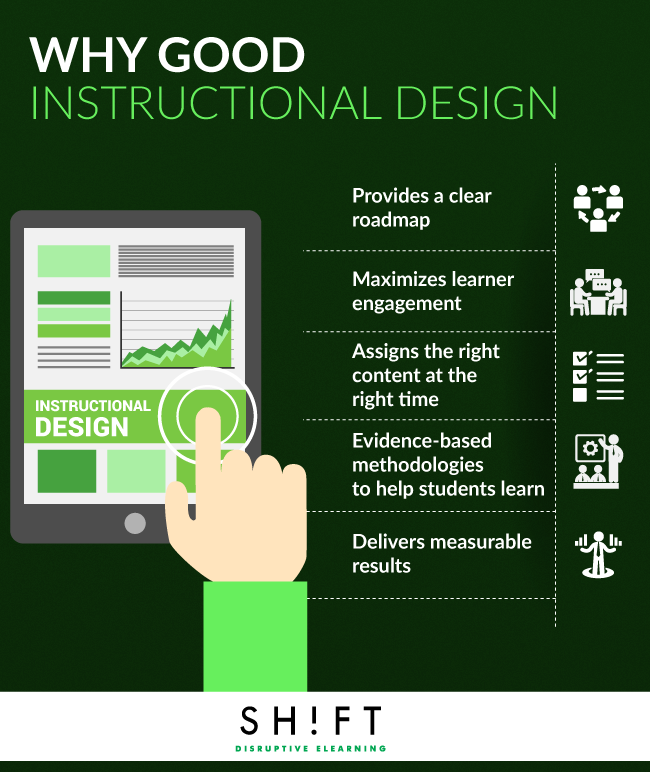Did you know that Instructional Design (ID) began in the Second World War to improve military training? This goes to show that ID isn't some new, smoke and mirrors concept; it's an evidence-based, rigorous discipline. And if your company isn't using instructional design effectively, they're losing out. This article should help set them straight.
Instructional Design Vs Good Instructional Design
First let's talk about what ID is and isn't. Texas University defines ID as the process of analyzing...wait, let's skip the academic speak. Instructional design is the way that we organize eLearning. It's the way we take a block of content and refine it into a learning project with value, strategy, goals, and measurable outcomes. Think of an eLearning instructional designer like a sculptor; they take blocks of concrete (the content), work with the commissioner (your company) and turn it into something valuable.
I've seen projects without good Instructional Design more times than I can remember. The expertise is there, the subject matter experts are there, the content is all prepped...and it flops. The learners don't come away with new knowledge or skills. Time and money down the drain. It's like walking into a classroom, handing the students a book and saying "learn." Maybe it'd save some time and money if you didn't hire a teacher, but would it work? Nope. That's why we need ID taken seriously.
But equally, the poetic approach above might not go down well in an L&D meeting, and metaphors don't work on people concerned with the bottom line. So here are some very practical and clear points to show your boss and help your company understand the 'why' of good instructional design and give it the respect it deserves.

1) Good Instructional Design helps you and your learners to understand your business
When an instructional designer works with a company, they collaborate with the Subject Matter Experts (SME) and analyze the material. This doesn't just mean that the learners get accurate info, it gives the SME an outside perspective and helps in clarifying, summarizing, and streamlining your business processes. Even the experts get to reflect on what the end-goal of an eLearning project is. In other words, a good IDer puts everyone on the same page.
2) Good Instructional Design Maximizes Learner Engagement
A good Instructional Designer takes the time to understand their audience. Why is that important? Because if you take a group of jazz fans to a Justin Bieber concert, they're not going to be clapping.
Good Instructional Designers have the know-how and skills to create and organize activities that are relevant, appealing, and give the course credibility. When learners believe in what they are doing as a valuable learning experience, they'll be more engaged and take on board the knowledge that you're offering more easily. Overall, this means greater return on investment.
Good Instructional Designers also understand how the memory works, how the brain learns and create their courses accordingly. eLearning courses that are not designed with these principles in mind can be frustrating to students.
3) Instructional Designers Know How to Select and Prioritize
It's not enough to be able to organize content effectively. In the modern world, we're bombarded with information every day - emails, text messages, meetings, and the Internet push us all to sensory overload sometimes. If you try and force your learners to do too much and don't identify what's important and relevant to them, you'll increase anxiety and decrease business performance.
I've seen eLearning programs that provide detailed overviews of accounting to entry-level receptionists. While this one is an obvious mistake, an Instructional Designer can pick out the relevance of materials in a way that only a trained specialist can. They get to decidewhich content is must-know (critical to achieving the learning outcomes), should-know (important background information that you can give away as handouts), and could-know (nice-to-know information that you may even omit from the course) information. This way, they can present the right information at the right time to the right learners and empower students to decide what and where they want to learn.
4) Training is a science, not an art
eLearning projects should be scientific and methodical. Instructional Designers don't just bring practical development skills to the table; they also have access to a wealth of theoretical knowledge and models. This informs the program, based on evidence of what method of delivery is most effective. Doing things the right way leads to better learning outcomes, which honestly, is what we need to provide when we invest time and money in a training program.
5) Instructional Designers don't just get results; they measure them too
Creating learning objectives isn't as easy as saying "I want them to be better at this."
Good learning objectives have to be measurable and performance-based, and they have to demonstrate a real improvement. Instructional Design encompasses some different methods to analyze exactly what learners have gained from an eLearning program.
Without this clear outline, guidance, and measurement of objectives, you can't know if a learning project has been successful. That's why ID is crucial to the success of developing your workforce in an increasingly knowledge-based economy.
So what’s the headline?
Without talented instructional design, an eLearning project might not fail, but it won't meet it's potential. If it doesn't, then workers won't develop their knowledge and skills. This translates into lower productivity, and you guessed it - lower return on investment.
Hopefully, you can use this information to turn your company into ID black belts, and start using eLearning that changes your organization and makes you and your colleagues happier, more productive, and highly skilled individuals.



